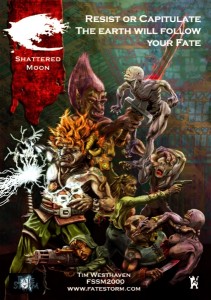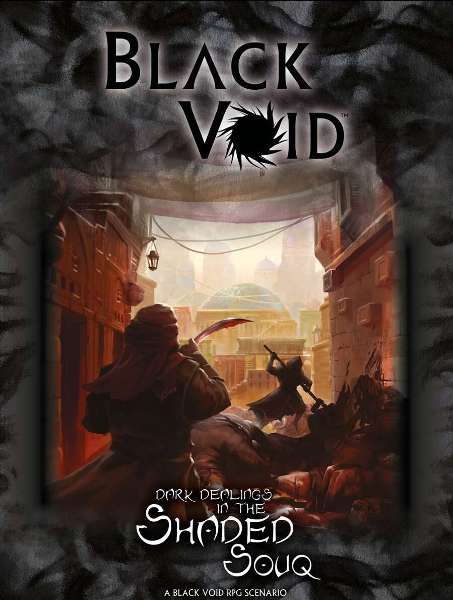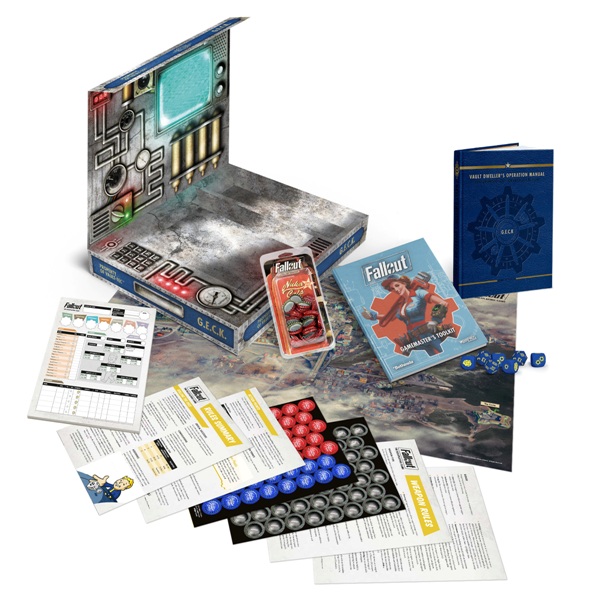Shattered Moon – First Impressions (Part 1)
By Aaron T. Huss
 Learn more about Shattered Moon here
Learn more about Shattered Moon here
Welcome to Part 1 of the Featured Product series for Shattered Moon and the FateStorm system. Part 1, First Impressions, discusses the initial details of the setting and system along with noting Rogue Marshal.
FIRST STUMBLES
I’m going to be upfront and honest here, something I’ve already discussed with the designer of FateStorm. This Featured Product series was supposed to discuss Rogue Marshal, Shattered Moon, and of course the FateStorm system. I started out this endeavor by delving into the Rogue Marshal book. Needless to say, I couldn’t make it through the explanations of the FateStorm system. However, I didn’t give up as the Rogue Marshal setting was extremely interesting. Instead, I delved into the Shattered Storm core rulebook and gave a thorough read of that book’s FateStorm system. Many “ah-ha” moments were had and the system started making a lot more sense.
Both core rulebooks are difficult to describe in terms of underlying theme. Rogue Marshal is sci-fi action and adventure, but the technology isn’t particularly high and there are a lot of gothic sci-fi and fantasy-like themes. Shattered Moon is definitely fantasy placed within a type of post-apocalyptic world, but it’s not really about the post-apocalyptic world and has definite dark fantasy themes. That said, both of these role-playing games have interesting settings and both are powered by the same system. However, the explanation of the FateStorm system is considerably cleaner and easier to understand within Shattered Moon compared to Rogue Marshal. It is thus that I regretfully turn down the opportunity to discuss Rogue Marshal and will instead focus on Shattered Moon and the FateStorm system.
If you truly like the FateStorm system, then I suggest picking up Rogue Marshal and focus on the slight updates to the system going from one setting to another instead of attempting to “relearn” the system from the Rogue Marshal standpoint.
THE SETTING
Shattered Moon takes place in a future version of Earth depicting a fantasy landscape caused by the shattering of the moon and the breaking of seals keeping creatures of the fey from running wild. Once the moon was shattered and that seal was broken, fey creatures who held the facade of a human for some number of years were freed from their “shackles” and morphed into their former fey selves. To me, this aspect of explaining why there are elves, dwarves, trolls, etc on Earth is much better than simply making them a part of Earth. There’s a reason why they now exist again, and there’s a reason why they used to have human forms. Right away, I was drawn in by the interesting twist to bringing the fey to Earth.
The shattering of the moon is the cause of the apocalyptic event, but it also ushers in the horror that now plagues the land. As stated above, Shattered Moon has elements of dark fantasy that border on fantasy horror. I say this because there are no mechanics for dealing with horror, sanity, corruption, or any other dark element that is often found in dark and weird fantasy. By placing this apocalyptic event in Earth’s near future, you have the possibility of coming across some type of sci-fi equipment to incorporate with your fey creatures (think post-apocalyptic sci-fi fantasy games like Gamma World).
The horror that caused their post-apocalyptic event involves the rejected Lilith (check your Bible stories…) and her horrific followers and offspring. These beings have essentially enslaved humanity, because they are too weak to fight the horrors, and only the incredible creatures of the fey can fight back. The overall purpose of the setting is to defeat Lilith and her kin.
This is an awesome set-up to the Shattered Moon setting, but it falls flat from there. A huge percentage of the core rulebook is given over to describing the FateStorm system, but without doing a lot of work connecting the system to the setting. I loved the set-up to the setting, but was let down when it didn’t continue on more thoroughly throughout the FateStorm explanation or at least consume a larger percentage of the book. Yes the setting is cool, but it left me with a lot of questions (for many Game Masters, this may be a preference).
THE SYSTEM
Shattered Storm is powered by the FateStorm system, designed by the same mind behind the Shattered Storm setting. This system is designed as a dice-less system where a character’s abilities are simply measured against an opponents according to how much weight they put behind their action (when going head-to-head for whatever reason). This means that if a PC taps into his abilities for a rating of 5 and his NPC opponent can only counter with a rating of 4, the PC wins. So what’s to stop the defender from always overcoming the aggressor? Because if you tap into your defenses too much, there won’t be anything left for an offensive maneuver. So why add anything against the aggressor? The more they exceed your rating, the more damage they do. This means the system uses tactical decision making on everyone’s part.
In addition to the dice-less mechanics, FateStorm uses a progressive initiative system whereas your initiative drops with each action you perform. Thus everyone performs multiple actions, but each individual action occurs on a different initiative. However many “points” are spent, that’s how far your initiative drops for the next action. This goes back and forth between PCs and NPCs as the highest initiative goes first.
This is obviously a very stripped-down explanation.
One thing to be very aware of is that FateStorm is not for those who are new to tabletop RPGs and it is definitely not for those who want a simpler gaming experience. It is not like other dice-less systems where resolution involves role-playing, storytelling, and the back-and-forth interaction of player decision. Instead, FateStorm replaces dice with what they call pips, basically points, that are applied to each action as described above. It’s yet another unique way of creating a tabletop role-playing experience.
SUPPORT
I spoke with FateStorm and Shattered Moon designer Tim Westhaven about my opinions about Rogue Marshal. He informed me that a new edition will be coming out utilizing a format and layout similar to Shattered Moon, including the description of the FateStorm system. This is a great step forward. Besides that, he has been busy creating supplements for Shattered Moon, looking deeper at the player character races. There isn’t much for adventure material, which for a new game is a definite need. This is made even more important since the core rulebook does not contain any introductory adventures, nor does it contain any notes on scaling encounters. This will be discussed more in Parts 2 and 3, but just note that you will have to spend time playing around with the system to understand how to properly scale your encounters.


